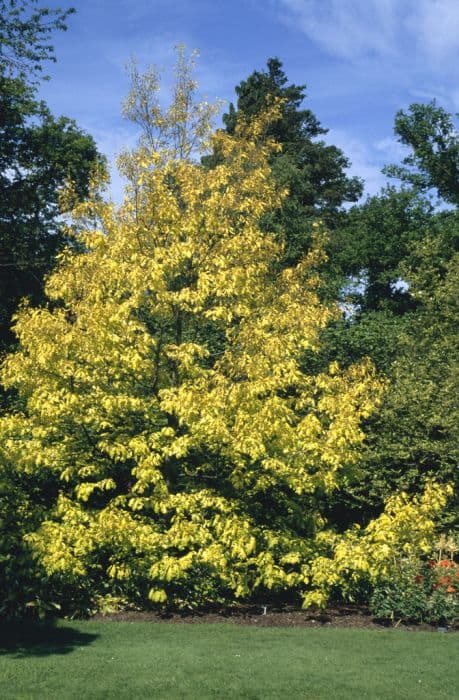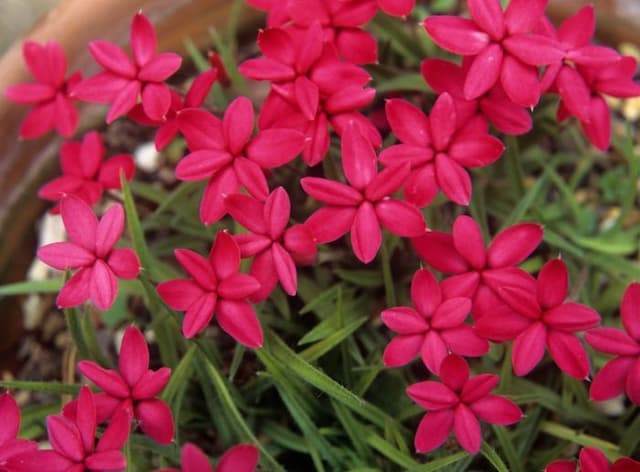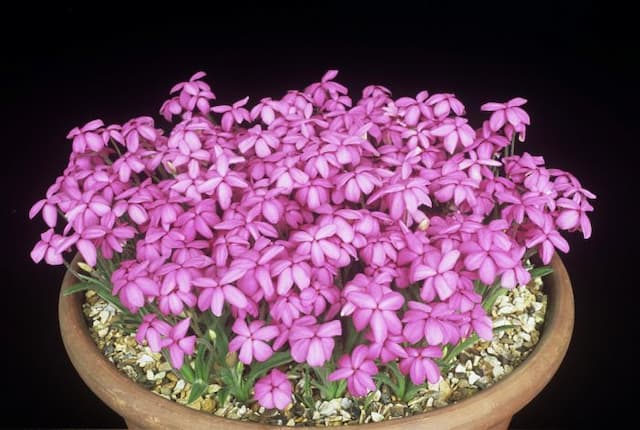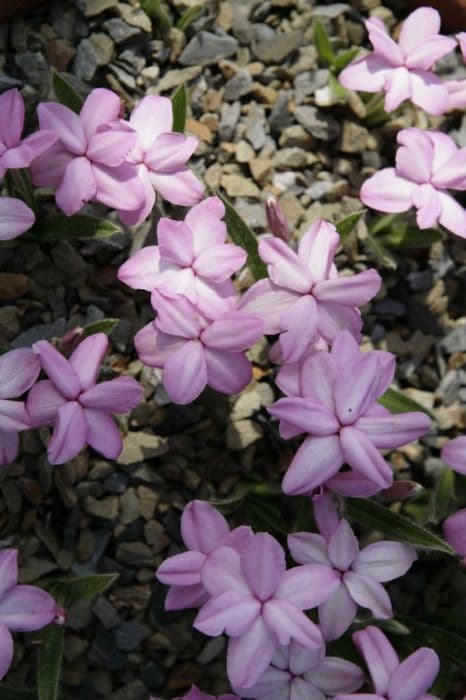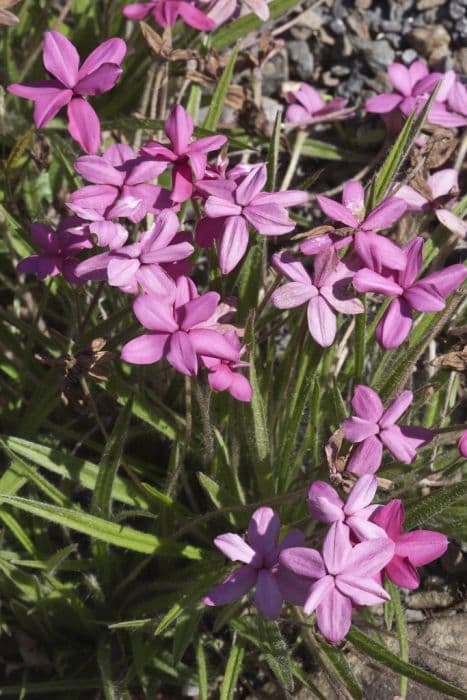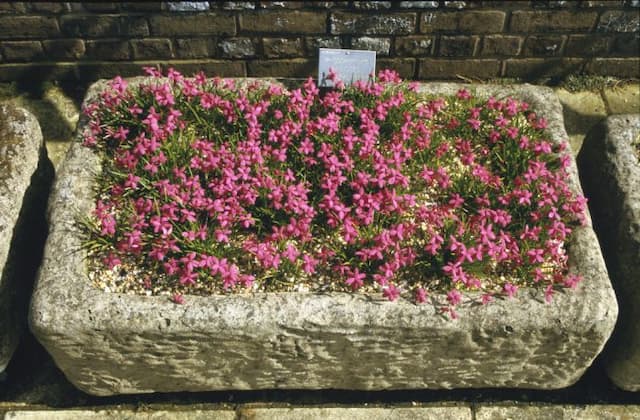Red Star Rhodohypoxis baurii 'Dawn'

ABOUT
Rhodohypoxis baurii 'Dawn', commonly known as the Red Star, is a small perennial plant that is cherished for its charming and colorful flowers. This plant features a tufted clump of narrow, grass-like foliage that is bright green in color. The leaves create a dense mound, serving as an attractive backdrop for the floral display that emerges during its blooming period. The star of the show is the flowers of the Red Star. These blossoms are delicate and exhibit a beautiful pale pink hue with a deeper pink coloration at the base. The petals are broad with rounded tips, coming together to form a star-like shape which gives this plant its common name. These flowers are typically arranged singularly at the end of slender, erect stalks that rise just above the foliage, creating a lovely contrast against the green leaves. The overall appearance of the Red Star is one of a compact and tidy plant that brings a splash of color to rock gardens, alpine settings, or wherever it graces the landscape with its presence. Its quaint and vibrant nature makes it a popular choice for gardeners looking to add a touch of whimsy and charm to their outdoor spaces.
About this plant
 Names
NamesFamily
Hypoxidaceae.
Synonyms
Red Star, Rhodohypoxis 'Dawn'.
Common names
Rhodohypoxis baurii 'Dawn'.
 Toxicity
ToxicityTo humans
Red star common name of Rhodohypoxis baurii 'Dawn' (Baur's red star) is generally considered non-toxic to humans. There is no widespread documentation of toxicity or poisoning from ingesting any part of this plant, so it is not commonly associated with any symptoms of poisoning for humans. However, it is always advisable to avoid eating any plant material unless it's known to be safe for consumption.
To pets
Red star, the common name of Rhodohypoxis baurii 'Dawn' (Baur's red star), is also generally considered non-toxic to pets. There is no significant evidence or reports suggesting that ingestion of any part of this plant can lead to poisoning in pets. Therefore, there are no specific symptoms of poisoning associated with this plant that pet owners need to be concerned about. However, ingestion of non-food items can sometimes lead to gastrointestinal upset in pets, so it is still best to prevent pets from ingesting plants not intended for their consumption.
 Characteristics
CharacteristicsLife cycle
Perennials
Foliage type
Deciduous
Color of leaves
Green
Flower color
Pink
Height
4 inches (10 cm)
Spread
6 inches (15 cm)
Plant type
Bulb
Hardiness zones
7
Native area
South Africa
Benefits
 General Benefits
General Benefits- Easy to Care For: Rhodohypoxis baurii 'Dawn', commonly known as Red Star, requires minimal maintenance, which is convenient for beginners or those with busy lifestyles.
- Compact Size: Being a small plant, it's perfect for rock gardens, alpine troughs, or small containers, where space is limited.
- Attractive Flowers: Red Star produces pretty pink flowers that can add a splash of color to any garden space.
- Ground Cover: Its mat-forming habit helps to cover the ground in garden beds, suppressing weeds and reducing soil erosion.
- Drought Tolerant: Once established, Red Star can withstand periods of drought, making it suitable for xeriscaping or gardens in dry climates.
- Seasonal Interest: Blooms in late spring to summer, which bridges the gap between early spring bulbs and summer perennials, providing continuous interest in the garden.
- Non-Invasive: Unlike some garden plants, Red Star tends to stay contained within its designated area without spreading aggressively.
- Attracts Pollinators: The flowers attract bees and other pollinators, which are beneficial for the health of the entire garden ecosystem.
 Medical Properties
Medical PropertiesThis plant is not used for medical purposes.
 Air-purifying Qualities
Air-purifying QualitiesThis plant is not specifically known for air purifying qualities.
 Other Uses
Other Uses- As an artistic inspiration, Rhodohypoxis baurii 'Dawn' can be used by painters and photographers alike for its striking pink blooms to create beautiful works of art.
- In miniature gardens, this small plant is ideal for adding a splash of color among tiny landscapes crafted to scale.
- Rhodohypoxis baurii 'Dawn' serves as an educational tool in botany classes to teach about plant growth patterns and bulbous plants.
- This plant can be used in wedding decorations, particularly in "living" floral arrangements or as live favors because of its lovely and delicate appearance.
- In crafting, the dried blooms can be used for making natural dyes or pressed flower decorations.
- During seasonal festivals, Rhodohypoxis baurii 'Dawn' can be an element of traditional table arrangements or used in garlands to celebrate spring.
- As a natural color indicator, the petals could potentially be used in pH indicator experiments due to pigment sensitivity in some plants.
- In culinary presentations, although not edible, the blossoms can be used as non-toxic decorations for plating gourmet dishes.
- For photography workshops, this plant is a prime subject for macro photography practice because of its intricate details and bright colors.
- In container fairy gardens, Rhodohypoxis baurii 'Dawn' is commonly used to create a whimsical, magical miniature setting.
Interesting Facts
 Feng Shui
Feng ShuiThe Red Star is not used in Feng Shui practice.
 Zodiac Sign Compitability
Zodiac Sign CompitabilityThe Red Star is not used in astrology practice.
 Plant Symbolism
Plant Symbolism- Hope: The Rhodohypoxis baurii 'Dawn', commonly known as the Red Star, often blooms with vibrant color early in the season, symbolizing new beginnings and hope.
- Resilience: As a hardy plant that thrives in rocky areas, the Red Star represents the ability to endure and thrive in challenging conditions.
- Charm: With its star-shaped flowers and attractive hues, it symbolizes the enchantment and beauty found in the smaller aspects of nature.
- Vitality: The lively colors and vigorous growth pattern of the Red Star signify health, energy, and vitality.
 Water
WaterThe Red Star plant prefers to be kept in moist soil during its growing season, from spring to late summer. It is important to water this plant regularly, about once every week, providing around 16 ounces of water each time. During the dormant period in winter, reduce watering significantly, only giving enough to prevent the soil from completely drying out. Over-watering can lead to root rot, so make sure the pot has good drainage.
 Light
LightRed Star plants thrive in bright, indirect sunlight but can tolerate partial shade. A spot near a south-facing window where the plant receives diffused light is ideal. Protect the plant from direct midday sun, which can scorch the delicate leaves.
 Temperature
TemperatureThe Red Star plant enjoys a temperate climate with ideal temperatures ranging between 60 and 70 degrees Fahrenheit. They can survive minimum temperatures of 50 degrees Fahrenheit and maximum temperatures of 80 degrees Fahrenheit. Avoid placing the plant in areas with drastic temperature changes or cold drafts.
 Pruning
PruningPrune the Red Star plant after blooming to encourage growth and maintain its shape. Cut back spent flower stems and any dead or discolored leaves. Pruning is typically done once per year, immediately after the flowering period has ended.
 Cleaning
CleaningAs needed
 Soil
SoilRhodohypoxis, commonly known as Red Star, thrives in a well-draining, loamy soil mix with added compost or peat for moisture retention. The soil pH should be slightly acidic to neutral, around pH 5.5 to 7. A blend of two parts loam, one part peat, and one part sharp sand or perlite is optimal for the Red Star's growth.
 Repotting
RepottingRed Stars, or Rhodohypoxis baurii 'Dawn', should be repotted every two to three years. This allows the plant to refresh its nutrients and encourages healthy growth. Repot during early spring before the plant resumes active growth.
 Humidity & Misting
Humidity & MistingRed Star plants prefer moderate humidity levels. They thrive in average room humidity but can benefit from slightly increased humidity. There is no need for excessively high humidity levels for the Red Star's optimal health.
 Suitable locations
Suitable locationsIndoor
Place in bright, indirect light with good airflow for indoor Red Star.
Outdoor
For outdoor Red Star, choose a sunny spot with afternoon shade.
Hardiness zone
7-9 USDA
 Life cycle
Life cycleRhodohypoxis baurii 'Dawn', commonly known as Rhodohypoxis, begins its life cycle with germination from seed, though it is more frequently propagated via division in early spring. The plant then develops fleshy, narrow leaves and in late spring to early summer, it produces star-shaped flowers ranging from white to pink colors. Following flowering, which can reoccur in flushes if conditions are favorable, Rhodohypoxis enters a phase of vegetative growth and bulb development. During late summer and autumn, the above-ground foliage begins to die back as the plant prepares for dormancy. Rhodohypoxis enters a resting period over winter, where the bulbs or corms remain dormant underground. With the return of warmer temperatures in spring, the cycle restarts as new shoots emerge from the corms, leading to further leaf development and flowering.
 Propogation
PropogationPropogation time
Spring-Early Summer
The Red Star plant, commonly known as Rhodohypoxis baurii 'Dawn', is commonly propagated through division. The best time for this method is during its dormancy in late fall or early winter. This is when the corm-like tubers can be carefully separated. To propagate by division, gently extract the plant from the pot or ground and shake off excess soil to reveal the tuber clusters. Using your fingers or a sterile knife, divide the tubers, ensuring that each division has at least one growth point. Then, replant the divisions promptly in a well-draining soil mix at a depth of about 1 inch (2.5 centimeters), water lightly, and anticipate new growth in the following growing season.
